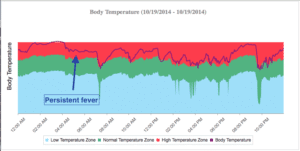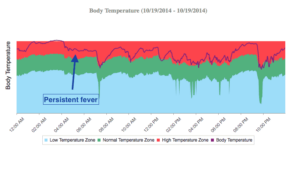PetPace, the provider of an innovative IoT collar for remote real-time monitoring and analysis of pet vital signs and activity, today released the findings of a new medical case study. The case study, available for download here, documents in detail how the PetPace collar enables, for the first time in veterinary medicine, non-invasive, minute-by-minute monitoring of core body temperature in pets.
The newest PetPace smart collar case study reviews the recovery of Ginger, a 10-year-old spayed female Weimaraner. Ginger was brought to a specialty referral veterinary hospital after her owner noticed a swelling on her neck, difficulty eating, lethargy and fever. She spent four days in the hospital, during which she underwent multiple tests and was diagnosed with Sialoadenitis, an inflammation of the salivary glands.
 A PetPace smart collar monitored Ginger’s vital signs, including temperature, on a minute-by-minute basis from her initial hospitalization until her post-release follow-up visit. Data was delivered in real time to the PetPace Professional Control Center and displayed on a computer screen placed near Ginger’s cage in the ICU.
A PetPace smart collar monitored Ginger’s vital signs, including temperature, on a minute-by-minute basis from her initial hospitalization until her post-release follow-up visit. Data was delivered in real time to the PetPace Professional Control Center and displayed on a computer screen placed near Ginger’s cage in the ICU.
Core body temperature in conscious patients is routinely measured using a rectal thermometer. Unfortunately, this method causes discomfort, and many patients resist or struggle during the procedure. This makes it difficult to monitor patient temperature frequently. Even in intensive care units, the temperature is rarely measured more than a few times per day. With traditional technology, continuous temperature monitoring can only be achieved with specialized equipment, used almost exclusively on sedated or obtunded patients. Home monitoring of temperature is nearly impossible for untrained pet owners.
The PetPace smart collar accurately reported fever in the first three days of Ginger’s hospitalization. On the evening of the third day, after new medications (Prednisone and Phenobarbital) were added to Ginger’s treatment protocol, the PetPace collar accurately documented the fever gradually subsiding. Following overnight temperature fluctuations, the fever finally abated on the morning of the fourth day. Ginger’s temperature remained in the normal range until her follow-up exam two days later, as documented by PetPace collar, which was sent home with Ginger to monitor her progress.
The PetPace collar provided Ginger’s caretakers and owners with continuous and accurate core temperature data, without the need for uncomfortable probing. PetPace documented not only Ginger’s initial fever but also its gradual resolution, providing her doctors with an indication that medication was helping to turn the condition around. Monitoring was continued at the patient’s home after discharge, reassuring clinicians that Ginger continued to recover.
Since fever was a primary clinical sign in this case, and its resolution was a key indicator of response to treatment, the continuous and reliable temperature data collected by the PetPace collar played an important case management role for Ginger.
Prior to the PetPace smart collar, remote, continuous, and accurate core temperature assessment of conscious patients was not possible in veterinary medicine, said Dr. Asaf Dagan, DVM, Diplomate ABVP (Canine and Feline practice), and PetPace’s Chief Veterinarian. Now, practitioners can monitor this important parameter – both in the hospital or the patient’s home – with high resolution. This enables the timely detection of temperature changes that can make the difference between a good or a bad outcome, he added.
Intensive monitoring is often required in the cases we typically see in a referral specialty center, said Dr. Teresa Lightfoot, DABVP, from BluePearl Veterinary Partners Specialty and Emergency Center in Tampa, FL, where Ginger was hospitalized. The previously-unavailable, high-resolution temperature monitoring provided by the PetPace collar was useful in managing this challenging case and documenting response to treatment, she continued.

